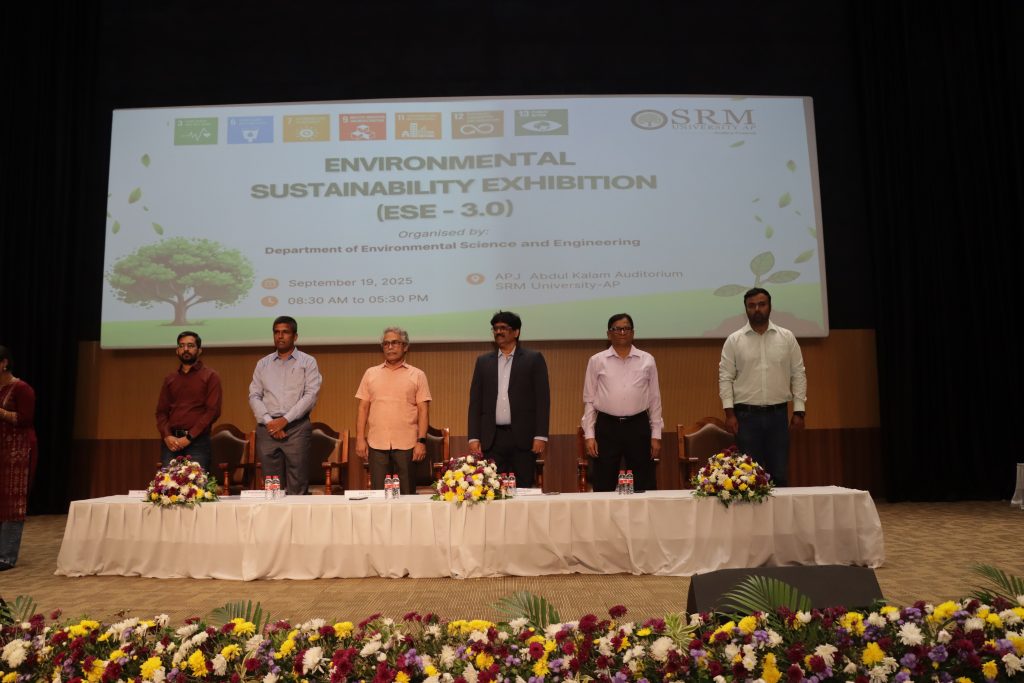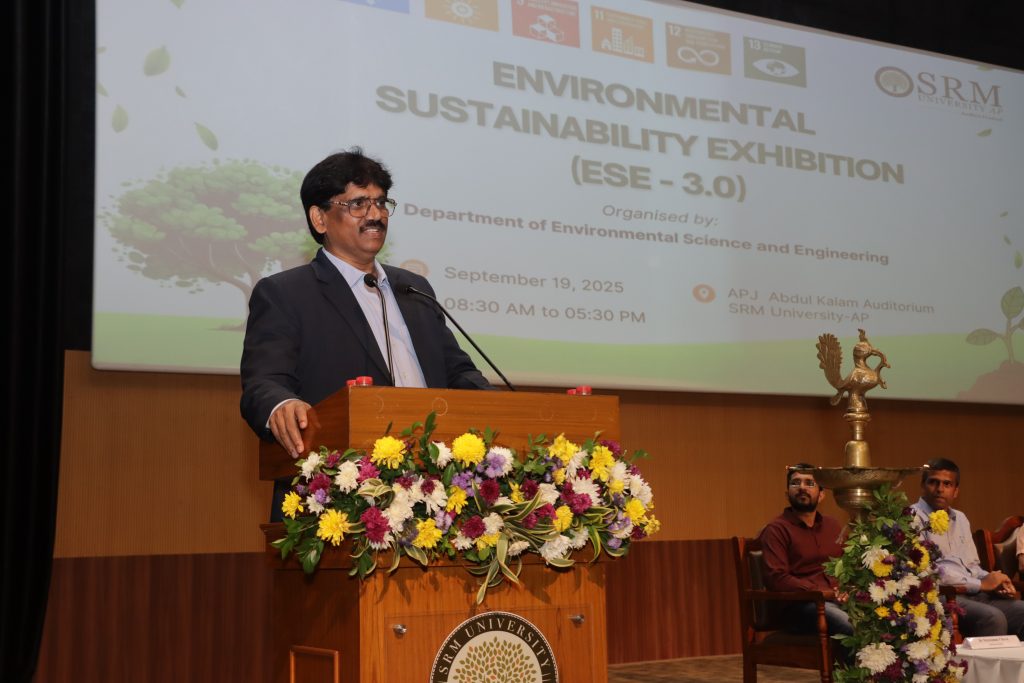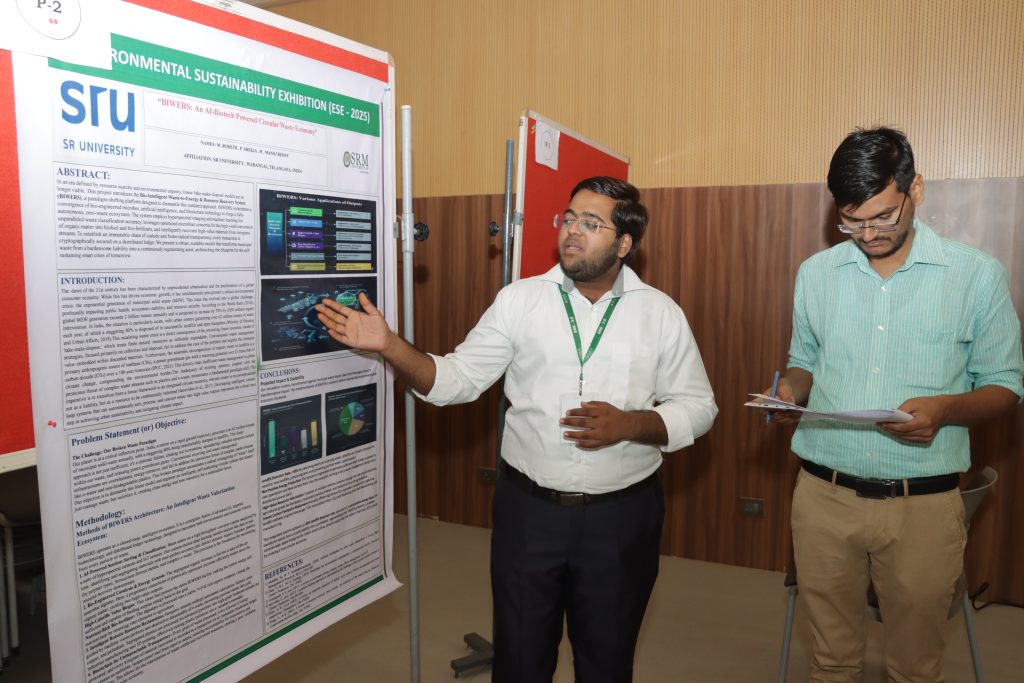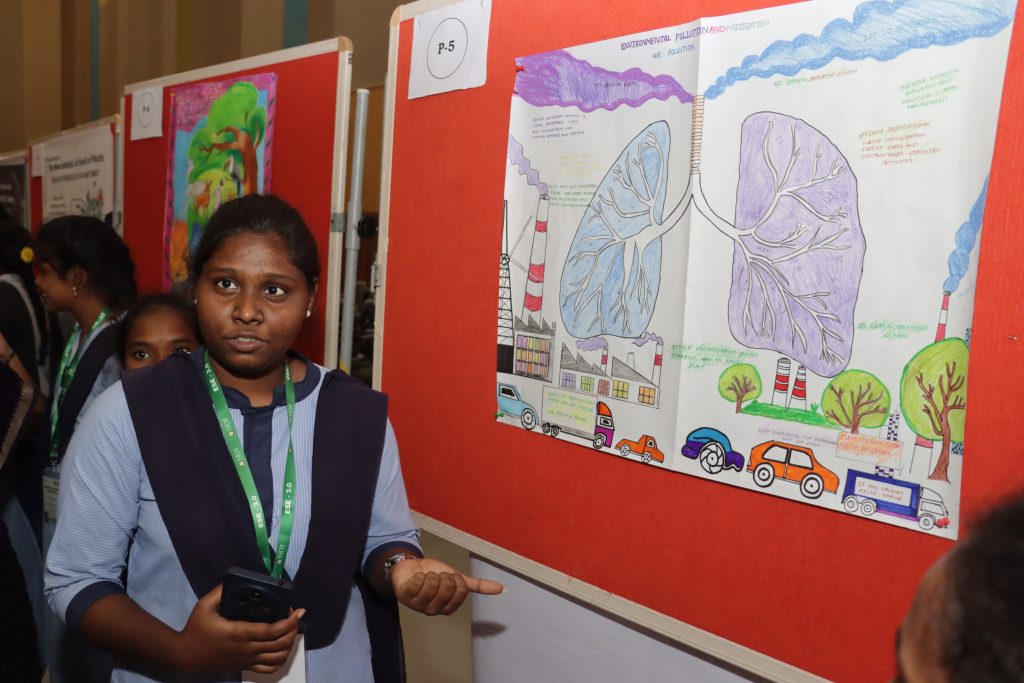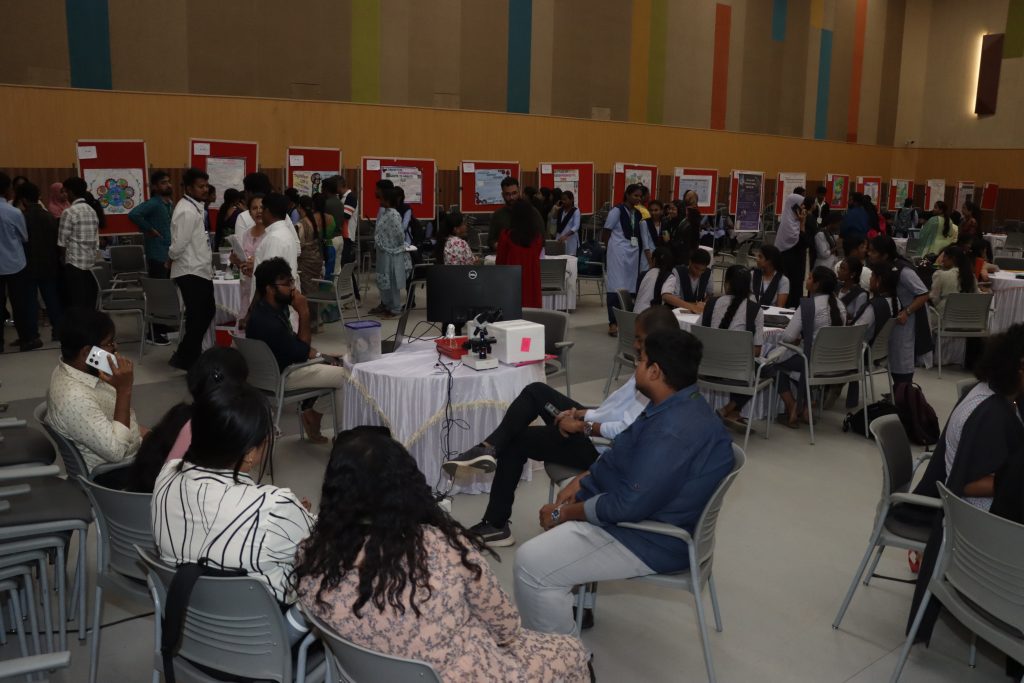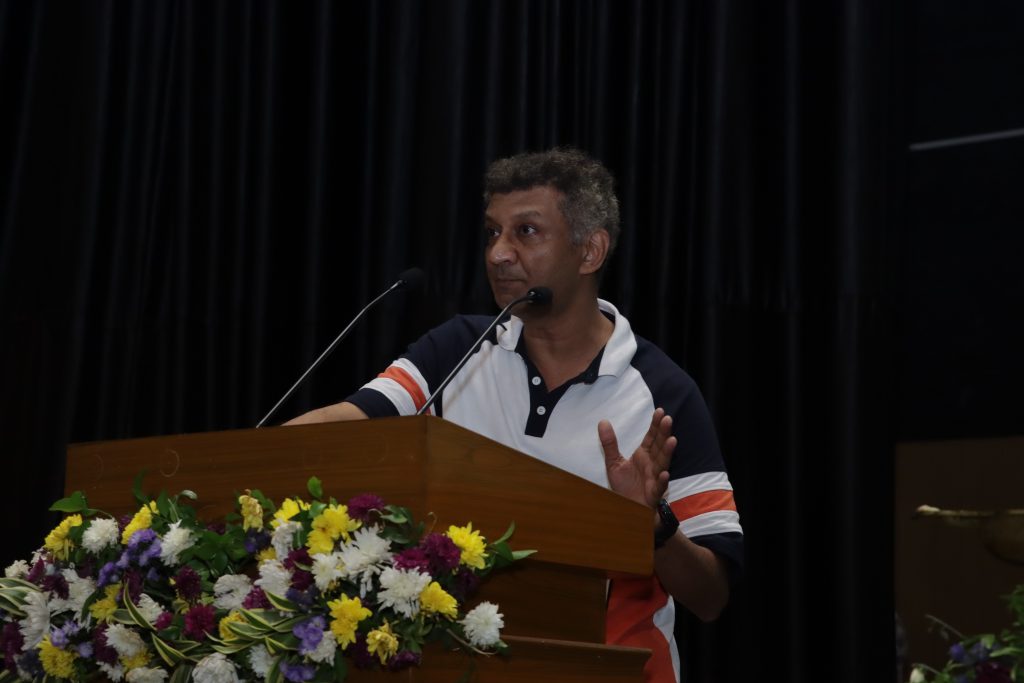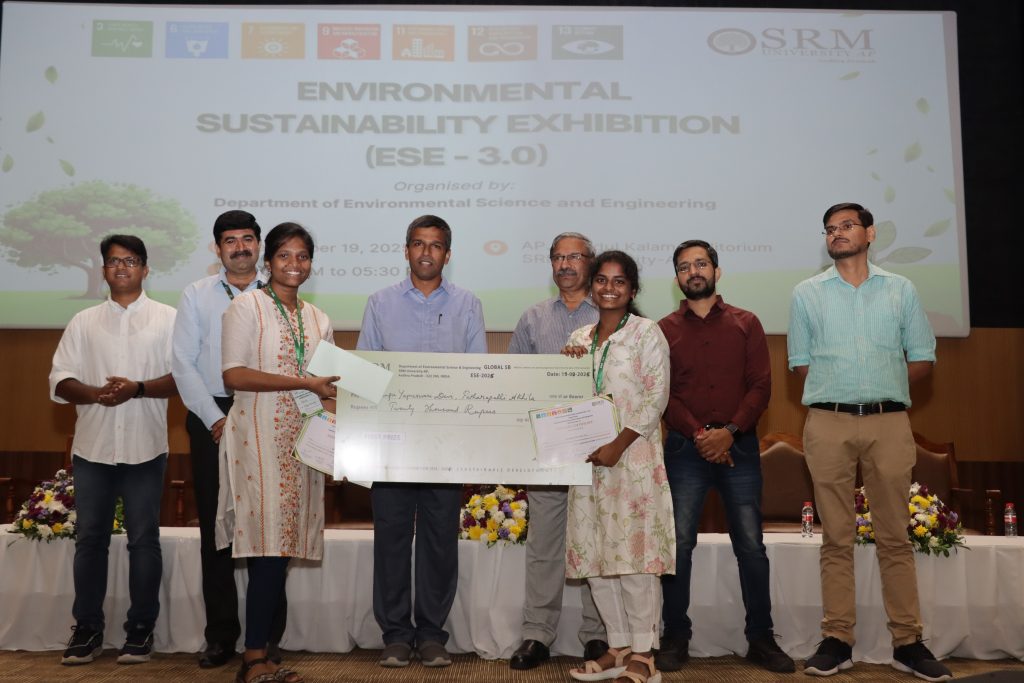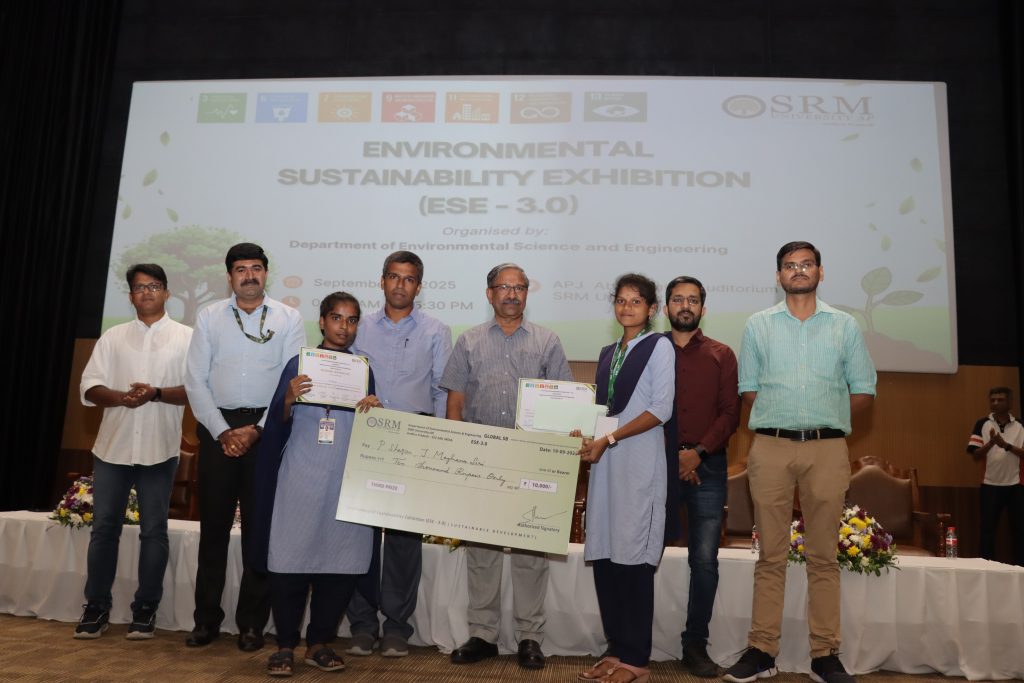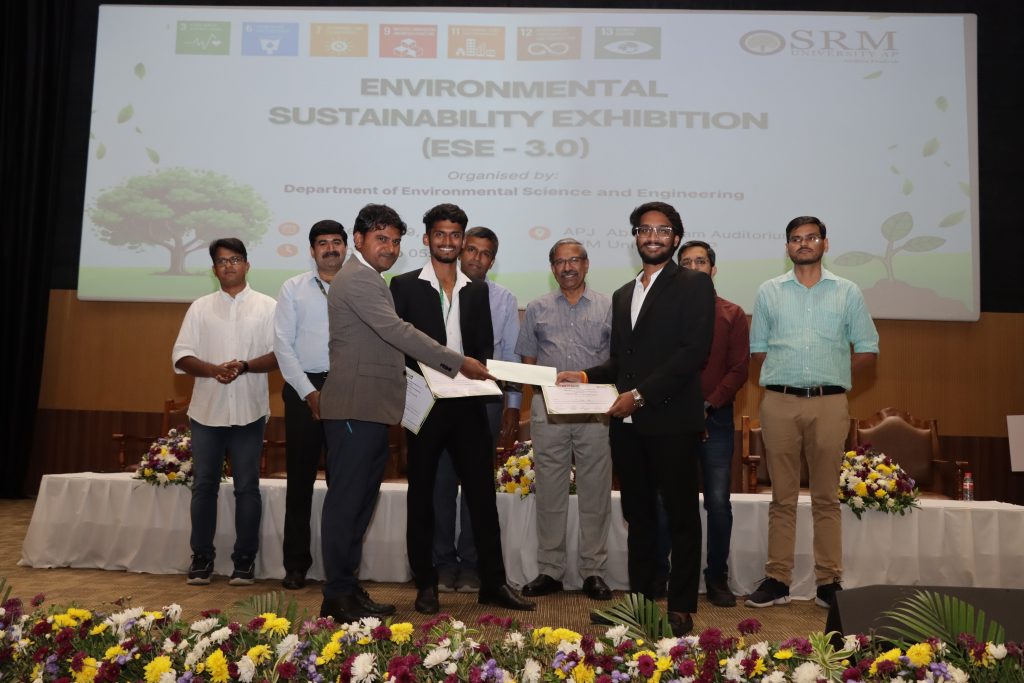Current Happenings ENVS News
- Innovating for a Greener Future: Environmental Sustainability Exhibition 3.0 at SRM AP September 23, 2025
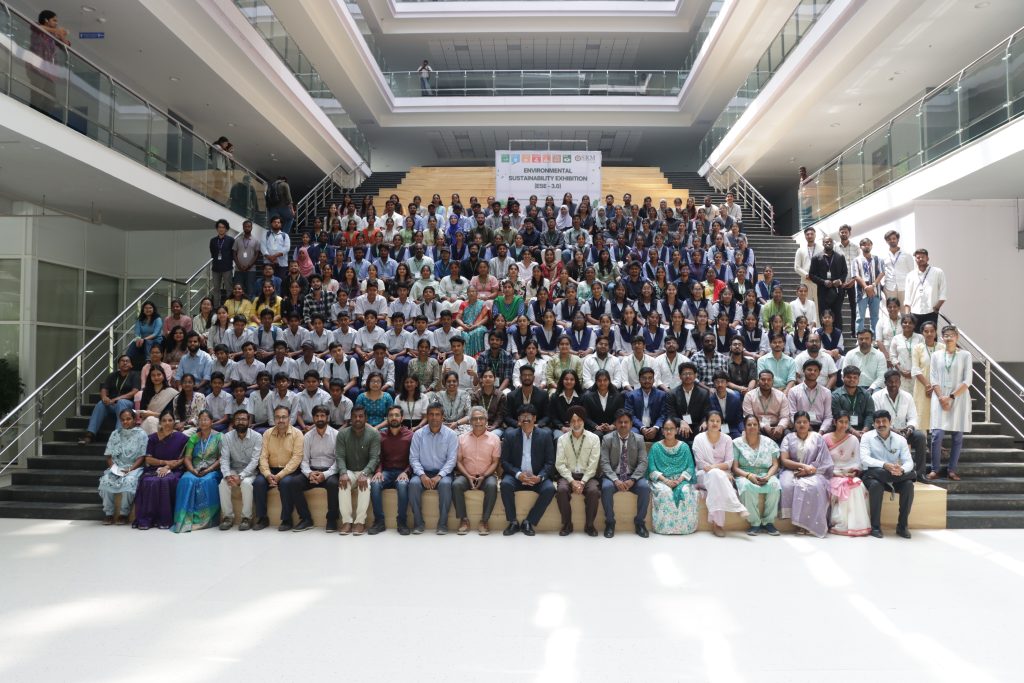
The Department of Environmental Science and Engineering, successfully hosted the third edition of the Environmental Sustainability Exhibition (ESE 3.0), a national-level platform dedicated to advancing knowledge, innovation, and collaboration in environmental protection and sustainable technologies, on September 19, 2025.
The event was inaugurated by Prof. Ch Satish Kumar, Vice Chancellor (I/C), who declared the exhibition open in the esteemed presence of Prof. C V Tomy, Dean of the School of Engineering and Sciences, Dr Rangabhashiyam Selvasembian, Associate Professor and Head of the Department of Environmental Science and Engineering, along with the, Heads of Departments, faculty members, staff, and students from various Universities and schools around the region.
In his inaugural address, Prof. Satish Kumar, Vice-Chancellor (I/C) , connected the exhibition’s vision to global efforts, stressing, “Sustainability is not an abstract idea but a responsibility towards future generations. Platforms like ESE 3.0 enable students to dream, innovate, and contribute to India’s commitment towards the United Nations’ Sustainable Development Goals and the Paris Climate Agreement.” He also emphasised the importance of achieving net zero emissions, drawing examples from states like Sikkim and nations like Bhutan.
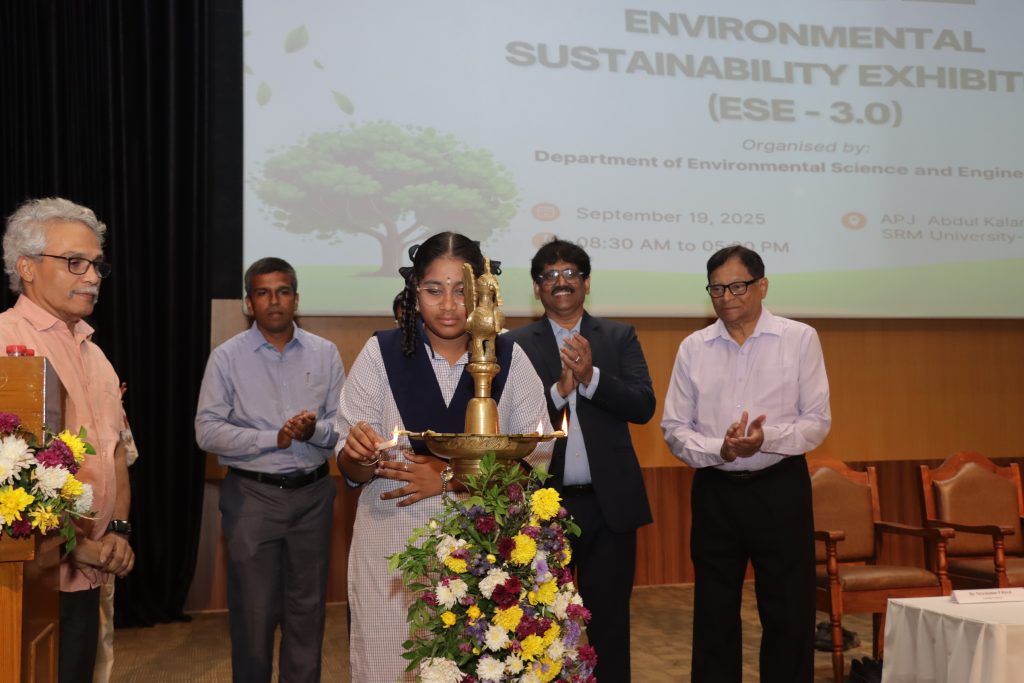
Carrying forward the legacy of the successful ESE 1.0 (2024) and ESE 2.0 (March 2025), this edition brought together 155 participants, hailing from states such as Punjab, Bihar, Telangana, and Andhra Pradesh. Around 60 exhibits, including 23 posters, 10 demos, and 25 oral presentations, represented prestigious colleges and universities nationwide. Each showcased innovative ideas rooted in their local contexts and challenges.
The top three winners were awarded a prize pool of ₹20,000, ₹15,000, and ₹10,000. Team P Akhila & V Yagneswari (Aditya University) secured the first prize, followed by Swarna Baisa & Bhanu Naik Jaloth (SR University, Warangal) and J Meghanasiri & P Sharon (SRR & CVR Govt. Degree College), who were awarded the second and third prizes, respectively.
Addressing the gathering, Dr Rangabhashiyam Selvasembian noted: “ESE 3.0 serves as an exceptional platform for students across India to present innovative ideas and initiatives for building a sustainable future. It motivates them to showcase their projects, interact with experts, and contribute meaningfully to the ongoing discourse on sustainability.”
Prof. C V Tomy further emphasised the importance of personal responsibility in everyday choices: “Every technological advancement, while beneficial, has an environmental cost. Even small, mindful actions such as conserving water and electricity make a significant difference when adopted collectively. Cultivating these habits early is the foundation of sustainability.”
The exhibition highlighted themes of air and water pollution mitigation, resource optimisation, sustainable development practices, waste management, renewable energy, and circular economy models. Participants presented working models, prototypes, posters, and research-based solutions, fostering rich academic exchange and dialogue.
Beyond the exhibition stalls, the event also included Poster presentations on climate change, environmental health, and resource equity, Hands-on training sessions introducing sustainability-driven advancements, Laboratory and campus visits offering exposure to SRM-AP’s state-of-the-art facilities and cutting-edge environmental research infrastructure.
With enthusiastic participation, thought-provoking exhibits, and meaningful interactions, ESE 3.0 reaffirmed SRM University-AP’s role as a hub for environmental innovation and sustainability research, dedicated to shaping solutions for the most pressing global challenges.
Continue reading → - Transforming Sustainability with Innovative Catalysts July 14, 2025
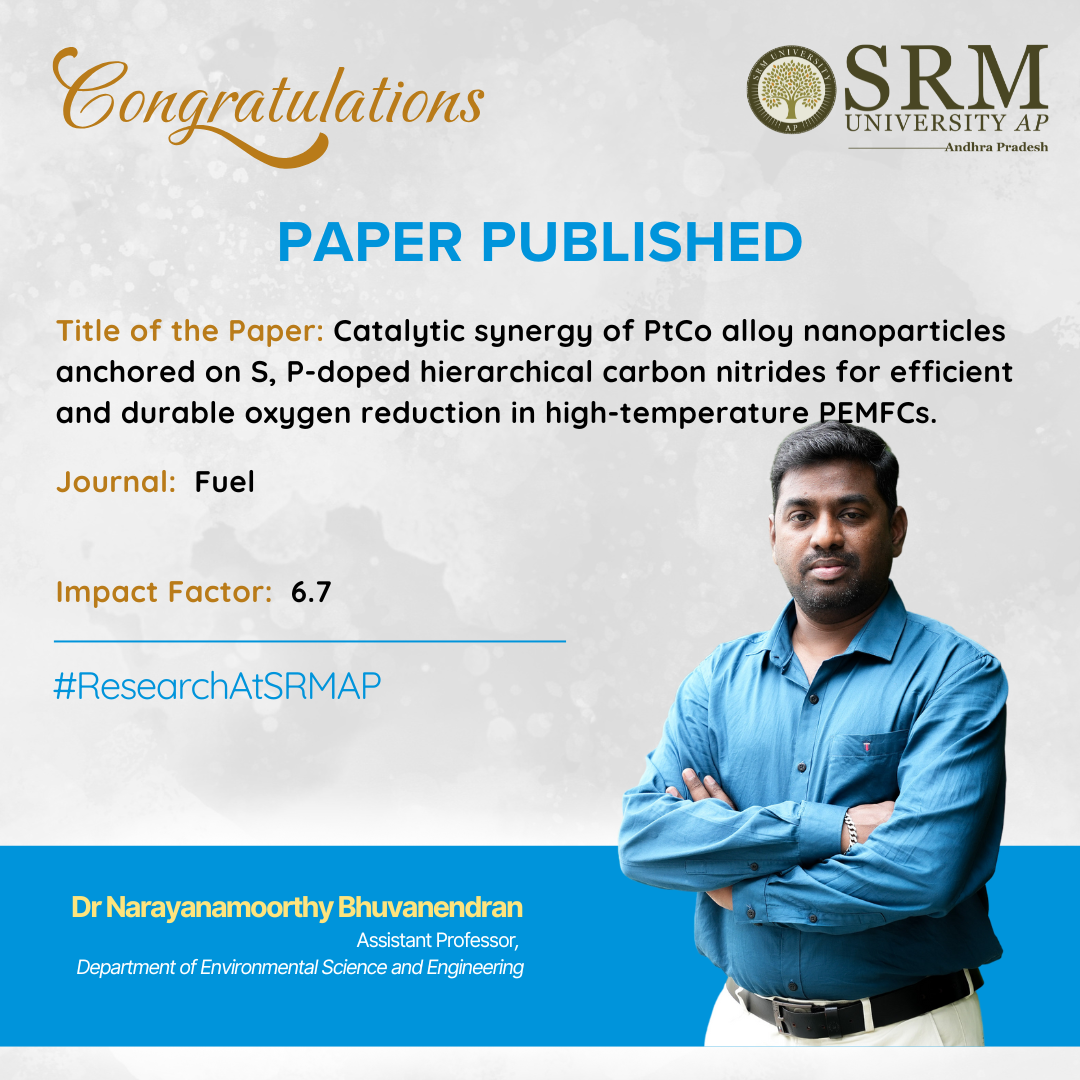 Assistant Professor, Dr Narayanamoorthy Bhuvanendran from the Department of Environmental Science and Engineering has published a research paper titled, Catalytic synergy of PtCo alloy nanoparticles anchored on S, P-doped hierarchical carbon nitrides for efficient and durable oxygen reduction in high-temperature PEMFCs. His research presents a new type of catalyst that could enhance the efficiency and longevity of fuel cells, making them more viable for sustainable energy applications.
Assistant Professor, Dr Narayanamoorthy Bhuvanendran from the Department of Environmental Science and Engineering has published a research paper titled, Catalytic synergy of PtCo alloy nanoparticles anchored on S, P-doped hierarchical carbon nitrides for efficient and durable oxygen reduction in high-temperature PEMFCs. His research presents a new type of catalyst that could enhance the efficiency and longevity of fuel cells, making them more viable for sustainable energy applications.Abstract:
Intensified electrochemical corrosion under high-temperature and phosphoric acid conditions poses a significant challenge to the catalysts in high-temperature proton exchange membrane fuel cells (HT-PEMFCs). Herein, a S, P-doped hierarchical porous carbon nitride (S, P-HCN) supported PtCo alloy catalyst was developed to address this issue. The multilayered porous structure of S, P-HCN ensures high metal dispersion, a large specific surface area, and enhanced mass transfer. The PtCo/S, P-HCN catalyst exhibits remarkable performance, with specific activity (1.27 mA cmPt-2 at 0.80 V), mass activity (0.51 mA µgPt-1 at 0.80 V), and electrochemical active surface area (ECSA) (39.9 m2 g-1Pt), surpassing commercial 20 % Pt/C by 2–3 times. Durability tests over 5000 potential cycles reveal excellent retention of mass activity (84 %) and specific activity (83.2 %) at 0.80 V, with only a minor 14 mV shift in half-wave potential. This enhancement stems from the synergistic effects between PtCo alloy nanoparticles and S, P-HCN, which modulate Pt- electronic structure, strengthen metal-support interactions, and boost catalytic efficiency. Single-cell HT-PEMFC studies demonstrate a peak power density of 377.4 mW cm−2 for PtCo/S, P-HCN, comparable to commercial Pt/C (398 mW cm−2), with reduced voltage degradation at low current densities. This work presents a promising approach for improving cathode materials and advancing HT-PEMFC performance.
Explanation in Research in Layperson’s Terms:
The growing demand for green energy has increased the interest in clean, sustainable, and efficient fuel for electricity generation. Hence, hydrogen is one of the promising choices as green energy source, which can be used as a fuel in fuel cell technology. Among various types of fuel cells, proton exchange membrane fuel cells (PEMFCs) are the fastest-growing energy technologies, especially in automotive applications, owing to their high-power density and rapid start-up and shutdown capabilities compared to other fuel cell types. PEMFCs are classified by operating temperature into low-temperature (LT-PEMFC) and high-temperature (HT-PEMFC). While LT-PEMFCs (operating at ∼ 80 °C) have advanced significantly, they face challenges such as complex heat and water management and the high cost of producing the required high-purity hydrogen fuel. HT-PEMFCs, operating at 150–200 °C, overcome low-temperature PEMFC limitations with fuel flexibility, simpler design, improved water management, and greater efficiency, while enhancing oxygen reduction reaction (ORR) kinetics and diffusion processes. Till to date, Pt/C is the most used catalyst in PEMFCs due to its high activity and stability. However, in HT-PEMFCs, phosphate species from the phosphoric acid electrolyte strongly adsorb onto Pt surfaces, blocking active sites for O2 adsorption and reducing overall cathode performance. To address this bottleneck issues, a novel hybrid support materials with 3D hierarchical porous morphology, high surface area, porosity, and more accessible active sites has been developed which provides distinct benefits over conventional carbon materials for enhancing ORR performance. Their extensive surface area and interconnected pores facilitate better active site distribution and efficient mass transfer during the ORR process and leads to extended fuel cell performance.
Practical Implementation and Social Implications:
In this work, we have design and developed the PtCo/S,P-HCN catalyst, through a simple hydrothermal process, constructs a synergistic combination of structural and compositional features that significantly enhance the cathodic ORR performance. The 3D porous architecture with uniformly distributed PtCo nanoparticles and S, P-doped carbon nitride matrix ensures improved Pt utilization, active site accessibility, and effective charge transport. Nitrogen doping (graphitic-N and pyridinic-N) facilitates efficient electron transfer, while heteroatom doping (S and P) optimizes *OOH binding energy, promoting oxygen adsorption and O–O bond cleavage. The interatomic alloy structure of PtCo modulates the Pt d-band center, further boosting ORR kinetics. These combined effects result in superior catalytic activity (SA: 1.268 mA cmPt-2, MA: 0.506 mA µgPt-1, ECSA: 39.9 m2 g-1Pt) and durability, retaining 84 % MA and 83.2 % SA after 5000 cycles with minimal half-wave potential loss (14 mV). In HT-PEMFC tests, it achieved a peak power density of 377.4 mW cm−2, matching commercial Pt/C (398 mW cm−2), while demonstrating greater PA resistance and stability. These findings highlight the synergistic effects of the PtCo/S,P-HCN catalyst and its potential as a robust ORR electrocatalyst for HT-PEMFC applications.
Collaborations:
Prof. Huaneng Su, Jiangsu University, China.
Future Research Plans:
Based on the observations from the above research, we plan to further explore modifications to the electronic properties of the catalyst to enhance the surface adsorption of reaction intermediates, thereby improving its electrocatalytic performance for various key electrochemical reactions.


